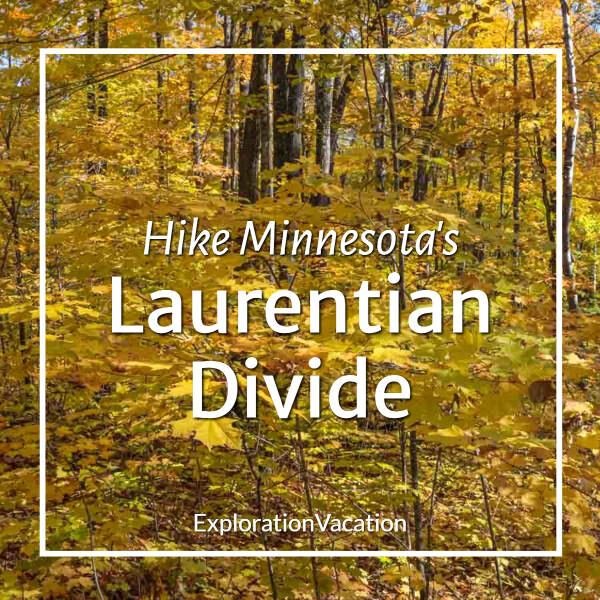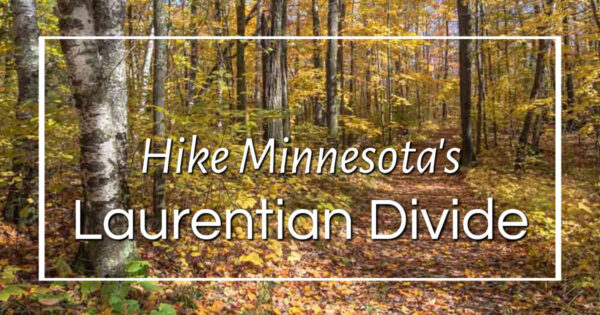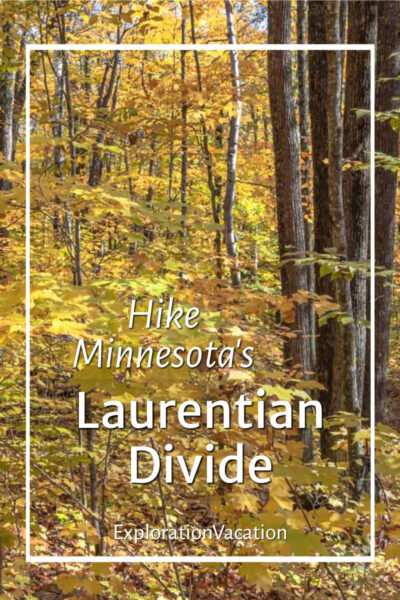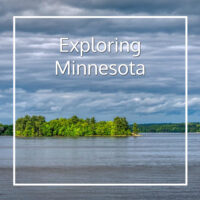Last updated on August 26th, 2023
A hike along the Laurentian Divide in northern Minnesota offers beautiful forest scenery and uncrowded trails. It’s lovely in any season, but fall brings a burst of brilliant color before winter arrives.
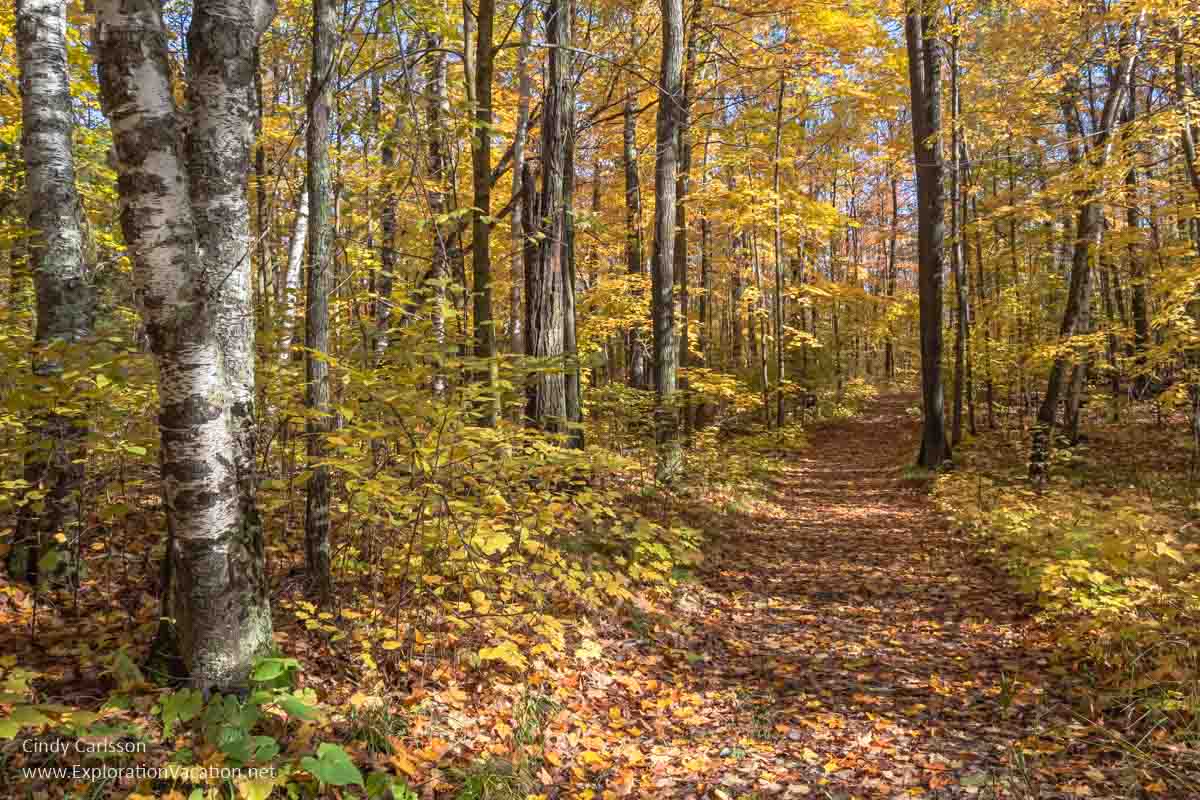
I use links to improve your experience, but some may also pay me a small commission if you use it to reserve a room, rent a car, or purchase goods or services. You don’t pay anything extra, but it helps keep this website running without intrusive advertisements. To learn more, review my policies and disclosures.
What is the Laurentian Divide?
Over the decades, a lot of family photos and selfies have been taken high in the Rockies along the Continental Divide, the ridge line where rain falling on one side flows east and on the other flows west.
But this is only one of five continental divides that mark the boundaries of major watersheds in the USA.
Where three watersheds meet
Two of those other continental divides run through northern Minnesota.
The longest in Minnesota is the Laurentian Divide.
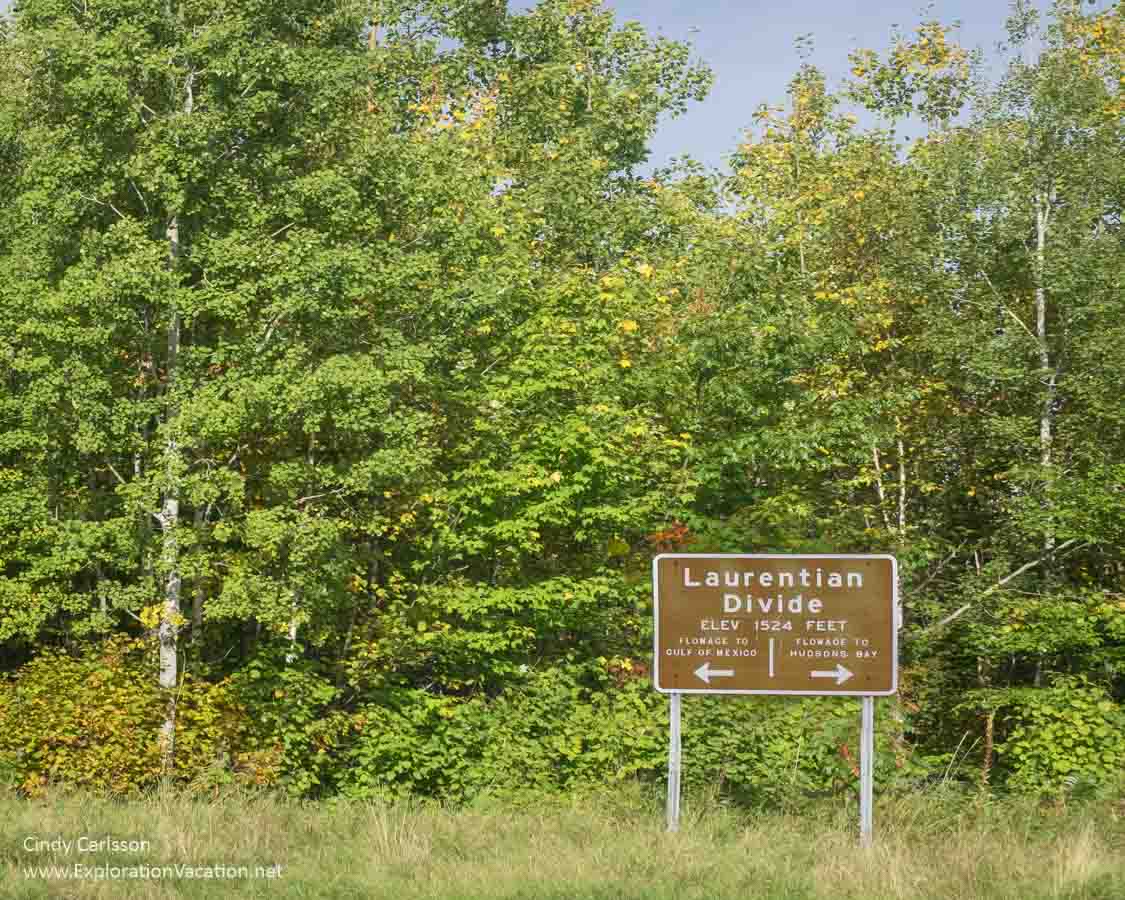
While not nearly as dramatic as the continental divide that runs along the Rocky Mountains, the ridge that winds through Minnesota directs the state’s waters flow. Also called the Northern Divide, this sub-continental divide runs from a peak in Glacier National Park all the to the Labrador Sea in Northern Canada. On one side of the divide, waters flow north into Canada and the Arctic, on the other they mostly flow south to the Gulf of Mexico.

Map of continental divides in North America by Pfly – Own work, CC BY-SA 3.0
I say “mostly” because the Saint Lawrence Divide intersects the Laurentian on the Mesabi Iron Range in northern Minnesota.
Known by the Ojibwe as the “Hill of Three Waters,” the upraised volcanic hill where these continental divides meet split the state’s waters three ways:
- North to Hudson Bay and on to the Arctic Ocean
- East into Lake Superior and on to the Atlantic Ocean
- South to the Mississippi River and Gulf of Mexico
The Ojibwe recognized the significance of this site. Because of its importance, the hill was a gathering point for the Ojibwe and generations before them. Today it is a small bit of green in the midst of a vast open pit mine.
An old border
The Northern Divide is also significant as the original northern boundary between the USA and Great Britain’s Canadian territory after the Louisiana Purchase in 1803.
Later, an 1818 treaty moved the boundary to the 49° latitude from Lake of the Woods west. This added formerly British territory in what is now northwestern Minnesota and northeastern North Dakota to the rapidly expanding United States.
Fall hiking along the Laurentian Divide
Both the Laurentian and Saint Lawrence Divides offer great hiking amid picture-perfect northern Minnesota scenery. And, while this is a great place to hike (or ski) almost any time of year, it’s particularly lovely in fall.
A number of trails wind along and across the Laurentian Divide as it twists and turns across Minnesota. However, I’m a big fan of the Continental Divide Wayside, a small rest area on Minnesota highway 38 between Grand Rapids and Marcell.
The highway here is part of the Edge of the Wilderness National Scenic Byway. Despite that designation, it never seems very busy. Maybe that’s because this area isn’t as well known as the North Shore or some of Minnesota’s other lakes areas. Or maybe it’s because there’s a lot of undeveloped space to get lost in up here. In any case, it’s nice that there never seem to be lots of other people around even at the peak of fall leaf season!
And fall is my favorite time to hike here, as the mix of trees varies enough to offer an ever-changing blend of red, orange, yellow, and green.

It’s also an easy place to hike, with a basic loop trail and a couple of overlooks.
The trail starts right at the parking lot. Aside from deciding whether to go left or right (it doesn’t really matter), the only other decision you need to make is whether or not to hike up to the Ice Road Overlook. Most of the trail runs through a mixed deciduous forest with a smattering of pine and a few maple groves. It’s the amount of color that mix creates that makes this such a great walk during the fall.


Of course, there are also plenty of small details to watch for, including a wide variety of mushrooms, lichen, and moss.

And, if you are quiet and come early in the morning, you’ll likely meet a few deer along the trail.
While there are a couple of scenic overlooks, hiking here is about enjoying the forest’s beauty and solitude.

Plan your visit to the Laurentian Divide
Although some sources now refer to it as the Northern Divide, in Minnesota it will almost always be called the Laurentian Divide. It’s also occasionally described only as the “continental divide,” which is confusing since the Saint Lawrence Divide is so near.
While the Laurentian Divide twists very unevenly across the state, the most scenic portions are located to the east of Bemidji, running to and through the Mesabi Iron Range and then north and east before disappearing into Canada near Lake Superior. This post only covers the portion in and around the Mesabi Iron Range in Koochiching, Itasca, and Saint Louis counties.
While this is great hiking country at any time of year, fall usually brings spectacular color. This area was once part of Minnesota’s vast pine forest. When loggers harvested virtually all of them, the forest returned as a mixed woodland of pine and a variety of deciduous trees that combine to form a brilliant tapestry of color each fall.
The Continental Divide Wayside
I’ve featured the Continental Divide Wayside because it is a favorite of mine and a bit of a hidden gem. The trail system here is not extensive, making it a nice stop for a short hike during a day of exploring a variety of sights in the area.
Other hikes along the Laurentian Divide
Since the Laurentian Divide takes a convoluted path through western and northern Minnesota, there are many places where hikers can access it. In the lakes area near the Mesabi Range, trail systems along and over the divide include:
- Laurentian Divide Recreation Area, accessed through the Laurentian Divide Rest Stop on US Highway 53 near Virginia
- The Continental Divide Trail at Savanna Portage State Park
- Cut Foot Sioux Trail near Deer River
- Giant’s Ridge near Biwabik
Hull Rust Mahoning Mine View
The Hill of Three Waters is located in Hibbing, at the heart of Minnesota’s Iron Range. The site sits, literally, within an active iron mine. To be more specific, it sits inside the Hull Rust Mahoning Pit, the world’s largest open pit iron mine. The hill is just a tiny part of a vast ruined red landscape formed by dozens of mine pits expanding into each other over the past century.
Mine owners preserve the hill’s unique geology, biology, and history as part of an understanding with the local Ojibwe people. Oddly, there is no iron in this particular spot. That’s probably fortunate, as it means there’s no reason for the mine to destroy it except as a matter of convenience.
However, the fact that the Hill of Three Waters still exists does NOT mean you can go out and explore it.
The closest you can get is the Hull Rust Mine View overlook.
This is a new overlook. It replaces a previous one that provided a view of the pit and the Hill of Three Waters. I assume the new location also provides a view of the hill, but I’m not sure where it is located in relation to the old overlook and have yet to visit the new one myself.
If you’d like to know what it’s like to actually visit the site where the three watershed meet, check Aaron Brown’s story on his visit to the Hill of Three Waters back in 2012. (And then go and see what else Brown is writing about, as he has a deep understanding of northern Minnesota and the Iron Range past, present, and future.)
Walk or bike the Mesabi Trail
The Mesabi Trail also runs through this area. When finished, it will offer about 155 miles of paved trail between Grand Rapids and Ely.
While not quite complete, over 130 miles of paved trail are available along the route. The longest complete section runs out of Grand Rapids. However, other paved sections are found in various spots along the trail’s entire length.
A permit is required to use a bike, inline skates, or skate board on the trail. Both 3-day and annual wheel passes are available from a number of local merchants and bike shops or online. The 3-day passes are also available at self-pay kiosks in communities along the trail.
Pedestrians can use the trail for free.
Fiction set along the Laurentian Divide
Sometimes the best way to get a feel for life in a particular place is through fiction.

For a fictional view of life in northeastern Minnesota, take a look at novels by Minnesota author Sarah Stonich.
Both Vacationland and Laurentian Divide are set in a fictional town not too far from the east of the sites mentioned above. I started with Laurentian Divide, but Vacationland is actually the first book in the series – set in the same place with the same characters, but at a different time.
Look for all of Stonich’s novels on AbeBooks.

